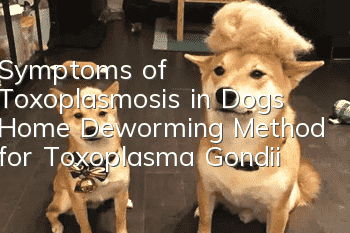Symptoms of Toxoplasmosis in Dogs Home Deworming Method for Toxoplasma Gondii

Transmission routes of Toxoplasma gondii in dogs
The causative agent of Toxoplasmosis is Toxoplasma gondii, referred to as Toxoplasma gondii. Its entire development process requires two hosts. Cats are the ultimate host of Toxoplasma gondii. In the epithelial cells of the cat's small intestine, schizophrenia and gametogenesis similar to the development of coccidia are carried out. Finally, oocysts are formed and excreted with cat feces. The oocysts undergo multiplication and development in the external environment. An infective oocyst containing two sporangia.
Toxoplasma gondii is not strict in its selection of intermediate hosts. It is known that more than 200 species of animals, including mammals, birds, fish, reptiles and humans, can serve as its intermediate hosts. Cats can also serve as intermediate hosts for Toxoplasma gondii. In the intermediate host, Toxoplasma gondii can reproduce asexually in nucleated cells in tissues and organs throughout the body. Animals become infected by eating infectious oocysts in cat feces or the meat, offal, exudates, excretions and milk of intermediate hosts containing Toxoplasma gondii or cysts. Tachyzoites can also infect the skin and mucous membranes, and can also infect the fetus through the placenta.
Symptoms of Toxoplasma gondii in dogs
(1) Clinical symptoms: mostly asymptomatic latent infection. Infections are common in puppies and young dogs, and symptoms can be severe. Fatal cases have also been reported in adult dogs. Symptoms are similar to canine distemper and canine infectious hepatitis. The main symptoms include fever, cough, anorexia, mental discomfort, weakness, eye and nose secretions, pale mucous membranes, difficulty breathing, and even severe bloody diarrhea. Some sick dogs experience severe vomiting, followed by paralysis and other neurological symptoms. Pregnant bitches can miscarry or give birth prematurely, and their puppies often have bowel movements, difficulty breathing, and movement disorders. Blood tests, in the acute phase, showed a decrease in red blood cells and an increase in neutrophils. Neutropenia and monocytosis are rare. In chronic cases, the total number of white blood cells increases, mainly neutrophilia and thrombocytopenia, but there is no bleeding tendency.
(2) Laboratory examination: It is easy to be confused with canine distemper, especially neurological canine distemper, relying solely on clinical symptoms. Therefore, after comprehensive judgment such as epidemiological analysis and clinical symptoms, the diagnosis must be confirmed by detecting the pathogen or confirming an increase in antibody titers in the serum.
Toxoplasma treatment plan for dogs
For acute infection cases, sulfadiazine (SD), 70 mg per kilogram of body weight, or trimethoprim (TMP), 14 mg per kilogram of body weight can be used mg, taken orally twice daily for 3-4 days. Because the solubility of sulfadiazine is low and it is easier to precipitate crystals in urine, it should be taken with an equal amount of sodium bicarbonate and drink more water. In addition, sulfonamide-6-methoprim (sulfamethoxazine, sulfamethoxine, SMM, DS-36) or sulfonyl dapsone (SDDS) can be applied.
How to prevent Toxoplasma gondii in dogs
Do not feed raw meat, prevent dogs from preying on rodents, and prevent cat feces from contaminating the feed.
- Is it better for Dogo dogs to have their ears erect or cropped? A case of Dogo dog’s ear erection surgery will tell you
- What do dogs eat to protect their stomach? It is important to protect their stomach and treat gastrointestinal diseases in dogs.
- How to tell if your dog is fat? Is your dog overweight?
- Will your dog catch a cold if you blow the air conditioner? What should you do if your dog catches a cold if you blow the air conditioner?
- What should you pay attention to when your dog drinks water? Don’t be careless when it comes to your dog’s drinking water.
- The dog's mouth bites and shakes. Why does the dog's mouth occasionally shake and bite?
- How to cut a dog's hair? Do you know how to cut a dog's hair correctly?
- Can dogs eat raw eggs? Why can’t dogs eat egg whites?
- Common Dog Problems in Summer How to Deal with Different Dog Problems
- How to keep dogs away from skin diseases. If you do this, will you see if your dog will still be infected with skin diseases?



